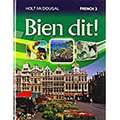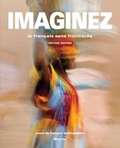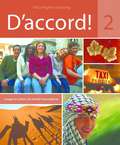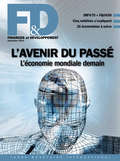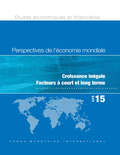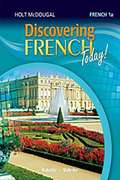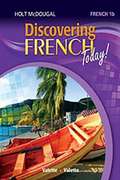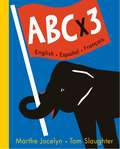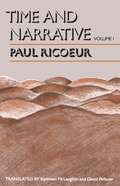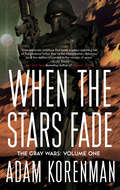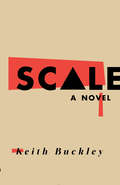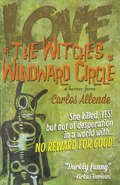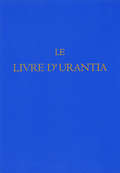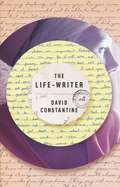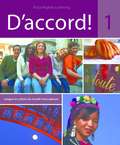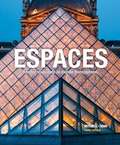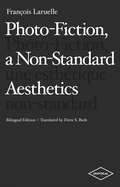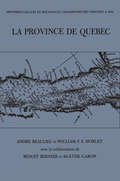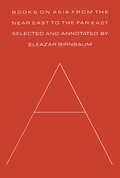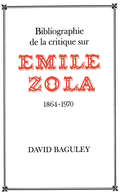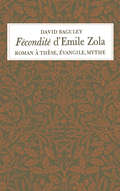- Table View
- List View
Holt McDougal French 3, Bien dit!
by John Demado Séverine Champeny Marie PonterioNIMAC-sourced textbook
Imaginez: le français sans frontières, cours de français intermédiaire
by Cherie MitschkeNIMAC-sourced textbook
enVisionMath, Common Core [Grade 3]
by Randall I. Charles Janet H. Caldwell Mary CavanaghNIMAC-sourced textbook
AP French: Preparing for the Language and Culture Examination
by Richard LaddNIMAC-sourced textbook
D'accord! Langue et culture du monde francophone, [Level] 2
by Vista Vista Higher LearningNIMAC-sourced textbook
Perspectives de l'économie mondiale, Avril 2015: Croissance inégale Facteurs à court et long terme
by Fonds monétaire internationalA report from the International Monetary Fund.
Discovering French Today!, French 1A, First part = Première partie
by Jean-Paul Valette Rebecca M. ValetteNIMAC-sourced textbook
Discovering French Today!, French 1B, Second Part = Deuxième partie
by Jean-Paul Valette Rebecca M. ValetteNIMAC-sourced textbook
Abc X 3: English - Español - François
by Marthe JocelynFrom airplane/avión/avion to zigzag/zigzag/zigzag, Marthe Jocelyn and Tom Slaughter have created a unique ABC for the very young. The book works perfectly in three languages, English, Spanish, and French (English, Español, and Français). In each case, deceptively simple paper cuts will delight the eye while young readers explore words in three languages. The book has been carefully constructed to accommodate each language, including the letters which occur in Spanish, but not in English or French. Earlier collaborations by Tom Slaughter and Marthe Jocelyn have received raves from critics. This new addition to their library is yet another excellent introduction to modern art, to words, and this time to the fun of languages
Time and Narrative, Volume 1
by Paul Ricoeur Kathleen Mclaughlin David PellauerTime and Narrative builds on Paul Ricoeur's earlier analysis, in The Rule of Metaphor, of semantic innovation at the level of the sentence. Ricoeur here examines the creation of meaning at the textual level, with narrative rather than metaphor as the ruling concern. Ricoeur finds a "healthy circle" between time and narrative: time is humanized to the extent that it portrays temporal experience. Ricoeur proposes a theoretical model of this circle using Augustine's theory of time and Aristotle's theory of plot and, further, develops an original thesis of the mimetic function of narrative. He concludes with a comprehensive survey and critique of modern discussions of historical knowledge, understanding, and writing from Aron and Mandelbaum in the late 1930s to the work of the Annales school and that of Anglophone philosophers of history of the 1960s and 1970s. "This work, in my view, puts the whole problem of narrative, not to mention philosophy of history, on a new and higher plane of discussion."--Hayden White, History and Theory "Superb. . . . A fine point of entrance into the work of one of the eminent thinkers of the present intellectual age."--Joseph R. Gusfield, Contemporary Sociology
When The Stars Fade: Volume 1
by Adam KorenmanIn distant future, humanity is recovering from a bloody civil war. Pilots CAMERON DAVIS and GEORGE LOCKLEAR, reservists with Sector Patrol, prepare for a long weekend off. That vacation is permanently cancelled when two alien armadas--the BOXTI and NANGOLANI--arrive near Earth. Though humanity wins the battle, the war quickly turns one-sided. One of Earth’s colonies is rendered uninhabitable. George dies saving his friend, and Cameron is sucked through a wormhole and disappears. Far away on the moon Kronos, JOSH RANTZ competes in a huge Army competition. Despite most of his unit falling to the enemy, Josh and his squad continue to win larger and larger victories. They are oblivious to the goings on of the universe, isolated on purpose by the war-game’s designer, Doctor MARKOV. When the exercise ends, Josh notices a meteor striking down nearby. He finds an injured Cameron, somehow transported across the stars to the military base. Moments later, the BOXTI arrive and invade. Outnumbered and outgunned, Josh and the soldiers on Kronos rally and push back the BOXTI horde. Summoned by their masters, the BOXTI leave the stunned humans behind.
Scale
by Keith BuckleyRay Goldman will outdrink you, out-party you and, unfortunately for him, probably outlive you. As a hopeless and struggling indie rock musician, Ray's best chance of discovering any beauty and purpose in his dysfunctional life will come only when he ceases to struggle against life itself. These are his memoirs. Scale chronicles Ray Goldman’s journey downward through the adversarial trials that sometimes prove necessary in facilitating an eventual ascent into truth and happiness. The odd chapters of the novel find Ray, now a 31-year-old guitar player, seeking fulfillment in the wake of a life-altering tragedy while the even chapters see him reflecting on the depravity and selfishness that hastened his descent towards it. Scale is about the relationship between instability and balance, death and resurrection, perception and reality, but ultimately it is about the endless war waged between our disquieted minds and our noble hearts. Fans of pop culture, Americana, Punk Rock music, and Charles Bukowski’s Ham on Rye . . . look out!
LoveorTheWitchesofWindwardCircle
by Carlos AllendeVenice, California Home to the broken, the dispossessed, and other scary folk. In our prayers, we mispronounce the words of the paternoster; we curse the womb of the anomalous woman; we deny Christ and the Eucharist, and we praise Pilate’s decision every Friday. Instead of fasting during Lent, we offer our bodies and souls to our master, Satan. Nineteen-year-old Josie García is torn between true love with a down-and-out poet and the monetary stability that only a rich husband can provide. She owes rent--two months--and while her little landlady is docile enough to pretend that she has forgotten about the money, she’s also a self-taught witch, planning to chop Josie’s head off and use it as the main ingredient in a potion to recover her lost youth and become the beautiful woman she never was. Creepy, campy, and yet incredibly lyrical, Love, or the Witches of Windward Circle is a wildly imaginative tale that spans five decades, connecting the otherworldly occult to the out-of-this-world bohemia of fiftiies Venice Beach.
Le Le Livre d'Urantia
by Multiple AuthorsVous avez découvert le chef d'œuvre littéraire répondant aux questions concernant Dieu, la vie dans l'univers habité, l'histoire, le futur de ce monde et la vie de Jésus. Le Livre d'Urantia harmonise histoire, science et religion en une philosophie de vie pleine d'espérance et de sens nouveau. Vous cherchez des réponses, lisez le Livre d'Urantia !Le monde a besoin de nouvelles vérités spirituelles, amenant l'homme et la femme modernes à une relation personnelle avec Dieu. Bâtissant sur l'héritage des religions, le livre dévoile une destinée éternelle pour l'humanité, la foi vivante étant la clé du progrès spirituel personnel et de la survie éternelle. Ces enseignements offrent de nouvelles vérités pouvant élever et faire avancer la pensée et la croyance humaines pendant les prochains 1000 ans.Un tiers du Livre d'Urantia est l'histoire stimulante de la vie de Jésus et une révélation de ses enseignements originaux. Ce récit panoramique décrit la naissance, l'enfance, l'adolescence, les voyages et aventures de sa vie d'adulte, le ministère public, la crucifixion et ses19 apparitions de résurrection. Jésus n'est plus le personnage principal du Christianisme mais un guide pour les chercheurs, de toutes religions et de tous milieux.
The Life-Writer
by David ConstantineAfter the death of her beloved husband, Katrin, a literary biographer, copes with the loss by writing his personal history. While researching the letters and journals he left behind, however, she comes to the devastating conclusion that his life before their marriage was far richer than the one they shared. To understand and recreate the period of his greatest happiness--a period of intense friendship and love in the fall and winter of 1968, with a young French woman named Monique--Katrin embarks on a heartbreaking journey to discover the man she never fully knew.
Le Le Livre d'Urantia
by Multiple AuthorsVous avez découvert le chef d'œuvre littéraire répondant aux questions concernant Dieu, la vie dans l'univers habité, l'histoire, le futur de ce monde et la vie de Jésus. Le Livre d'Urantia harmonise histoire, science et religion en une philosophie de vie pleine d'espérance et de sens nouveau. Vous cherchez des réponses, lisez le Livre d'Urantia !Le monde a besoin de nouvelles vérités spirituelles, amenant l'homme et la femme modernes à une relation personnelle avec Dieu. Bâtissant sur l'héritage des religions, le livre dévoile une destinée éternelle pour l'humanité, la foi vivante étant la clé du progrès spirituel personnel et de la survie éternelle. Ces enseignements offrent de nouvelles vérités pouvant élever et faire avancer la pensée et la croyance humaines pendant les prochains 1000 ans.Un tiers du Livre d'Urantia est l'histoire stimulante de la vie de Jésus et une révélation de ses enseignements originaux. Ce récit panoramique décrit la naissance, l'enfance, l'adolescence, les voyages et aventures de sa vie d'adulte, le ministère public, la crucifixion et ses19 apparitions de résurrection. Jésus n'est plus le personnage principal du Christianisme mais un guide pour les chercheurs, de toutes religions et de tous milieux.
Exploring French
by Joan G. SheeranPictorial exercises and activities introduce French vocabulary words and phrases. Also discusses the geography and culture of France.
D'accord! Langue et culture du monde francophone, [Level] 1
by Vista Vista Higher LearningNIMAC-sourced textbook
Espaces: Rendez-vous avec le monde francophone
by James G. Mitchell Cheryl TanoNIMAC-sourced textbook
Photo-Fiction, a Non-Standard Aesthetics
by François Laruelle Drew S. BurkTwenty years after cultivating a new orientation for aesthetics via the concept of non-photography, François Laruelle returns, having further developed his notion of a non-standard aesthetics. Published for the first time in a bilingual edition, Photo-Fiction, a Non-Standard Aesthetics expounds on Laruelle's current explorations into a photographic thinking as an alternative to the worn-out notions of aesthetics based on an assumed domination of philosophy over art. He proposes a new philosophical photo-fictional apparatus, or philo-fiction, that strives for a discursive mimesis of the photographic apparatus and the flash of the Real entailed in its process of image making. "A bit like if an artisan, to use a Socratic example, instead of making a camera based off of diagrams found in manuals, on the contrary had as his or her project the designing of a completely new apparatus of philo-fiction, thus capable of producing not simply photos, but photo-fictions." One must enter into a space for seeing the vectorial and the imaginary number. Laruelle's philo-fictions become not art installations, but "theoretical installations" calling for the consideration of the possibility of a non-standard aesthetics being of an equal or superior power to art and philosophy, an aesthetics in-the-last-instance that is itself an inventive and creative act of the most contemporary kind.
Le province de Quebec
by Agathe Garon W.F.E. Morley André Beaulieu Benôit BernierThere is no doubt that local and regional history, considered by many as a kind of minor historical study, has a pressing need for a systematic inventory of its resources. This collection shows the durability, the vividness, and the astonishing productivity of a sector of history which is the stronghold of the history-lover rather than the professional historian.The nature and content of each book determines its selection. For each book included, the compilers have weighed its contribution to local history and regional history rather than the style in which it is written--narrative, memoir, descriptive study, or novel. It is this criterion of selection that has permitted the retention of several general histories of a varied nature--Bouchette, Charlevoix, Nicholas Denys, La Potherie, Lescarbot, Hanotaux, Sulte, etc.-- where local and regional life takes on a major importance for reasons of order in history, method, or quite simply because local life is the principal object of the study itself. The editors have also retained certain works--those of George W. Brown, Arthur Buies, George M. Grant, Blodwen Davies, etc.--because they are primarily descriptive and contain numerous elements in which local history blends with the manners and customs of the inhabitants of certain regions.This bibliography is designed primarily for historiographers who have until now paid little attention to local, regional, or parochial history. It will also be invaluable for librarians who suffer from the numerous difficulties involved in the classification of such works. Since 1950, all works published in Canada are, by virtue of the book deposit law, provided to the National Library of Canada, and recorded in Canadiana.
Books on Asia from the Near East to the Far East
by Eleazar BirnbaumThis is a selected, annotated list of some 2,000 books on Asia in English and French currently in print, chosen with the aim of providing a long-term historical perspective for the general reader. The list is presented in four main parts: Asia as a whole; the Islamic world; India, South and Southeast Asia; the Far East. Subdivisions cover such topics as: general and reference works; history, social science, and law; history of literature; literature in translation; religion and ideas; arts, crafts, architecture, and science; and the lands in modern times.
Bibliographie de la Critique sur Émile Zola, 1864-1970
by David BaguleyZola scholars and those whose work in other fields--literary, historical, sociological, or artistic--brings them into contact with Zola and his works have long felt the need for a survey for the large corpus of writings on this important, widely read author. This bibliography provides just such a survey, admirably complete and intelligently organized. Aided in his research by several collaborators and by a number of libraries throughout the world, David Baguley has compiled some 8000 items covering the period from the first reviews of Zola's early works to 1970. Although his work does not pretend to be exhaustive, it contains extensive coverage of studies in English, German, Polish, and Spanish, as well as French, as essential items in many other languages. The entries are arranged chronologically by years and, within each year, alphabetically by author. An introduction outlines aims, principles, and uses. Researchers will also find helpful the list of unpublished theses on Zola from various countries, the index of authors' names and names appearing in titles and notes, and the index of themes. The latter uses the number assigned to each of the entries to facilitate speedy location of materials on particular topics--e.g. Germinal studies, Zola and the theatre, the Dreyfus case, and so on. Wherever appropriate, annotation has been provided that indicates the language, content, importance, and viewpoint of the items. This bibliography will be an indispensable reference guide for Zola scholarship.
Fecondite d'Emile Zola
by David BaguleyThis historical and critical study of Zola's Fécondité contributes much to an understanding of how the novel came to be written and of its achievements. Like Travail and Verité, the later books in the series Les Quatre Evangiles, Fécondité has not previously received significant critical attention. This study reveals and interprets the less obvious aspects of the work, its biblical and mythical themes, its sources and genesis. It also adds to our knowledge of Zola's later works through the examination of various ideological currents--particularly the impact of Malthusianism, its proponents and adversaries, and who among them Zola read in preparing this book. Fécondité deals with the particular problem of France's declining birth-rate at the end of the nineteenth century and, more generally, with the problem of decadence and cultural renewal. By the time that he wrote Fécondité, Zola had abandoned his naturalist aesthetic of scientific objectivity, if not also his working methods as a novelist. This study shoes how his didactic concerns continually asserted themselves in the structure and the use of rhetorical techniques in Fécondité. Specialists in Zola, and others more generally interested in the French culture of the late nineteenth century, as well as the particular demographic problems that Zola treats in the work, and the relationship of literature to primitive mythology, should find this study of particular interest.
